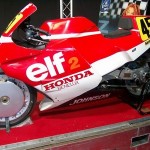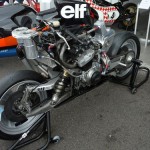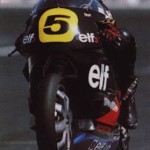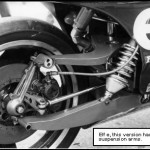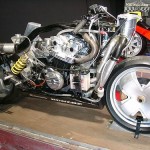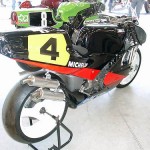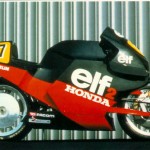Long forgotten: The crazy experimental bikes Elf built
 You know that feeling, when your pride and joy is sitting in the garage, tuned and tweaked to perfection. Just the way you want it. And yet you are already thinking of things that can be done to it. Ways in which it can be modified and tweaked that you have convinced yourself will improve the handling here, braking there, acceleration everywhere. We get that feeling because change, when you get down to it, is fun. Tinkering with things is fun. Going fast down the straight is great, but the thrill of diving on the brakes at the last second and leaning into the turn is better. And listening to that fresh roar from your trick new exhaust as you feed the power in out of the corner is better still, more so if it gives you that tenth of a second you needed to slip past the pesky mate who’s been one step ahead all season.
You know that feeling, when your pride and joy is sitting in the garage, tuned and tweaked to perfection. Just the way you want it. And yet you are already thinking of things that can be done to it. Ways in which it can be modified and tweaked that you have convinced yourself will improve the handling here, braking there, acceleration everywhere. We get that feeling because change, when you get down to it, is fun. Tinkering with things is fun. Going fast down the straight is great, but the thrill of diving on the brakes at the last second and leaning into the turn is better. And listening to that fresh roar from your trick new exhaust as you feed the power in out of the corner is better still, more so if it gives you that tenth of a second you needed to slip past the pesky mate who’s been one step ahead all season.
 So imagine the ideas and tech that can come about if the ones tinkering away in garages late at night are racing engineering experts, funded by the seemingly bottomless coffers of French petroleum giants. That is just what Elf decided to do when it began a program of experimental motorcycles that lasted from 1978 to 1988, searching for that innovation that would propel their riders, and their brand, to the top of the podium.
So imagine the ideas and tech that can come about if the ones tinkering away in garages late at night are racing engineering experts, funded by the seemingly bottomless coffers of French petroleum giants. That is just what Elf decided to do when it began a program of experimental motorcycles that lasted from 1978 to 1988, searching for that innovation that would propel their riders, and their brand, to the top of the podium.
The story of Elf began in 1939 with the discovery of a profitable gas field and the subsequent creation of Elf’s three founding companies; Régie Autonome des Pétroles, Société Nationale des Pétroles d’Aquitaine (1941) and the Bureau de Recherches de Pétroles (1945). It wasn’t until 1967 that the efforts of the company were consolidated into the state owned Elf brand. Market research at the time demonstrated the value of exposure through victory in competitive motorsport and Elf acted on this by partnering with Matra, another French company chiefly focussed in aeronautics and weaponry. The partnership was very successful in Formula 1, Formula 2 and Formula 3 and Elf was keen to continue and expand its presence in motorsport. When the partnership with Matra came to an end, Elf sought to develop its relationship with Renault in competitive motorsport, a decision which ultimately lead to Renault’s revolutionary turbo F1 car; “The sceptics were out in force. It was powered by – what? A 1500cc engine? Turbocharged? Few could believe it.” (Smith, 2008). Elf’s relationship with motorcycle racing began in 1972 and grew throughout the early 1970s with contracted riders and sponsorship of motorsport stables such as Honda.
 Things really got interesting when the French petroleum giant put its considerable resources behind experiments into unconventional motorcycle chassis design. Francois Guiter was head of marketing for Elf at the time and an enthusiastic proponent of the marketing benefit to be gained from motorsport. In particular he saw the potential in capturing the public’s imagination through association with innovation and success in motorsport; “to create an image of technical quality with a creative and dynamic outlook for its company, openly expressed to the public through competition” (Smith, 2008). He was introduced to Andre de Cortanze, one of Renault’s designers on the A500 and RS01, as well as the turbo A442 that won at Le Mans, through Elf’s relationship with Renault.
Things really got interesting when the French petroleum giant put its considerable resources behind experiments into unconventional motorcycle chassis design. Francois Guiter was head of marketing for Elf at the time and an enthusiastic proponent of the marketing benefit to be gained from motorsport. In particular he saw the potential in capturing the public’s imagination through association with innovation and success in motorsport; “to create an image of technical quality with a creative and dynamic outlook for its company, openly expressed to the public through competition” (Smith, 2008). He was introduced to Andre de Cortanze, one of Renault’s designers on the A500 and RS01, as well as the turbo A442 that won at Le Mans, through Elf’s relationship with Renault.
Cortanze had accrued extensive engineering and design experience in his work at Renault and combined this with an enthusiasm for endurance motorbike racing. His experience, coupled with his love of the sport, gave him many innovative design ideas that would bring together the strengths of each sport in a revolutionary motorbike design. Cortanze and Guiter met during the creatively charged period of testing with Renault and spent time in conversation, exchanging ideas. The result of this was that Guiter eventually allocated Cortanze a modest budget for a new bike incorporating Cortanze’s innovative engineering ideas.
 The ELF X was the first product of this partnership and was unveiled to the public at the 1977 Paris auto show. Powered by a two-stroke, four cylinder 750cc Yamaha TZ, the ELF X was the first step in translating Cortanze’s design philosophies to the design of motorbikes; “I wanted to achieve four aims: lower the center of gravity, incorporate ‘natural’ antidive suspension, reduce weight and eliminate the chassis completely as a separate entity” (Cortanze, from Cathcart). The X in the name stood for experimental and the bike certainly lived up to its name. The chassis was all but removed, with a double link steering setup consisting of an upright held in place by parallel forward-facing arms attached to one end of a stressed-member engine and a single sided cast magnesium swing arm attached to the other. The “car-type upright supports either a fixed stub axle or a live rotating axle for one-sided wheel mounting” (Foale, 2006), and allows wheels to be changed quickly, satisfying one of Cortanze’s core design objectives – quick wheel changes.
The ELF X was the first product of this partnership and was unveiled to the public at the 1977 Paris auto show. Powered by a two-stroke, four cylinder 750cc Yamaha TZ, the ELF X was the first step in translating Cortanze’s design philosophies to the design of motorbikes; “I wanted to achieve four aims: lower the center of gravity, incorporate ‘natural’ antidive suspension, reduce weight and eliminate the chassis completely as a separate entity” (Cortanze, from Cathcart). The X in the name stood for experimental and the bike certainly lived up to its name. The chassis was all but removed, with a double link steering setup consisting of an upright held in place by parallel forward-facing arms attached to one end of a stressed-member engine and a single sided cast magnesium swing arm attached to the other. The “car-type upright supports either a fixed stub axle or a live rotating axle for one-sided wheel mounting” (Foale, 2006), and allows wheels to be changed quickly, satisfying one of Cortanze’s core design objectives – quick wheel changes.
A stressed-member engine is one in which the engine itself forms part of the chassis or frame and through which structural loads may move. Stressed-member engines had been used in F1 since 1964, but were not popular features in motorbike design at the time. The innovative Lancia D50 was the first F1 car to make use of a load bearing engine in 1954, but it wasn’t until the Ferrari 158 in 1964 that a true stressed-member engine was employed. It took until 1967 and the Lotus 49 to popularise the design when it was used as part of the 49’s monocoque chassis. The use of a stressed-member engine in the design of the ELF X was clearly an avant garde decision, but it is that type of consideration that made the ELF X what it was. In the ELF X the fuel tank is mounted to the bottom of the engine, lowering the bike’s centre of gravity. A stressed-member engine allows designers to reduce the weight of the bike while increasing rigidity, however it requires an engine that can handle the strains placed on it and this became a problem with the “Yamaha two-stroke that proved unsuitable for use as a fully stressed member” (Cathcart).
Development of the ELF X never really reached its full potential, however it did prove to be an inspiration and a valuable learning experience. It garnered the attention of Honda who, after a private test session with one of their own riders, entered into collaboration with Elf, paving the way for the ELFe.
 As 1979 drew to a close it was decided that Honda would supply Elf with “works 1000cc RSC endurance engines” (Cathcart) and Cortanze would provide the design and engineering skills that would lead to the ELFe (for endurance). The ELFe was an evolution of the ideas born in the ELF X and came much closer to embodying Cortanze’s design principles of; “reduced weight, lower centre of gravity, improved anti-dive under braking and, elimination of conventional chassis, making the whole motorcycle as stiff and strong as possible” (Walker, 2000). The ELFe was entered into the World Endurance Championship in 1981 and was developed over three years of competition as it participated in every round until the end of the 1983; “its purpose of proving the basic theories to co-sponsor Honda already achieved” (Walker, 2000). It was fast and the engineering innovations employed in its design made it adaptable, however once again it suffered in terms of reliability. An aerodynamically streamlined version of the ELFe, the ELF R, was used to capture an impressive 6 world speed records at Nardo in Italy, 1986.
As 1979 drew to a close it was decided that Honda would supply Elf with “works 1000cc RSC endurance engines” (Cathcart) and Cortanze would provide the design and engineering skills that would lead to the ELFe (for endurance). The ELFe was an evolution of the ideas born in the ELF X and came much closer to embodying Cortanze’s design principles of; “reduced weight, lower centre of gravity, improved anti-dive under braking and, elimination of conventional chassis, making the whole motorcycle as stiff and strong as possible” (Walker, 2000). The ELFe was entered into the World Endurance Championship in 1981 and was developed over three years of competition as it participated in every round until the end of the 1983; “its purpose of proving the basic theories to co-sponsor Honda already achieved” (Walker, 2000). It was fast and the engineering innovations employed in its design made it adaptable, however once again it suffered in terms of reliability. An aerodynamically streamlined version of the ELFe, the ELF R, was used to capture an impressive 6 world speed records at Nardo in Italy, 1986.
The next phase of Elf’s experimental motorbike adventure was the development of a GP bike and entrance to the exciting world of GP racing. Honda was on board, once again, as was a new and increasingly important member of this story, Cortanze’s assistant; Dan Trema. The bike was the ELF2, also known as the ‘Black Bird’, which featured an experimental steering system in which the rider controlled the steering by pushing and pulling the handlebars forwards and backwards. During testing this system proved impractical, “the rider was not only too divorced from the road, but the system was over-sensitive” (Walker, 2000), and the bike was redesigned into the ELF2A. The ELF2A featured steering closer to that which was developed on the ELFe. However, the bike was also short lived and the team moved on to the ELF3.
 Dan Trema, who had been playing an increasingly integral role in the design of the bikes, and Serge Rosset took over the program when Cortanze departed to Peugeot rally (Walker, 2000). The ELF3 was the first fruit of their labour, featuring a more conventional, at least in comparison to the radical ELF2, design and a three cylinder Honda NS500. British rider Ron Haslam rode the ELF 3 in 1986 and ELF4 in 1987, scoring its first World Championship point at Jarama, winning in Macau in 1986 and finishing fourth overall in 1987. Development of the ELF3 was strong throughout the season and Elf began negotiations with Honda regarding the commercial applications of the design technologies they had refined over the preceding years. The ELF4 once again pushed conventional boundaries, testing an ultimately unsuccessful carbon-fibre chassis. However, it struggled with mechanical issues and Haslam was only able to enter it competitively toward the end of the 1987 season.
Dan Trema, who had been playing an increasingly integral role in the design of the bikes, and Serge Rosset took over the program when Cortanze departed to Peugeot rally (Walker, 2000). The ELF3 was the first fruit of their labour, featuring a more conventional, at least in comparison to the radical ELF2, design and a three cylinder Honda NS500. British rider Ron Haslam rode the ELF 3 in 1986 and ELF4 in 1987, scoring its first World Championship point at Jarama, winning in Macau in 1986 and finishing fourth overall in 1987. Development of the ELF3 was strong throughout the season and Elf began negotiations with Honda regarding the commercial applications of the design technologies they had refined over the preceding years. The ELF4 once again pushed conventional boundaries, testing an ultimately unsuccessful carbon-fibre chassis. However, it struggled with mechanical issues and Haslam was only able to enter it competitively toward the end of the 1987 season.
The ELF5 was the culmination of the design philosophies begun in the ELF X, offering “unparalleled braking stability… you could brake harder and later than on any conventional machine” and “exceptional chassis adjustability” (Cathcart). However, 1988 and the ELF5 marked the final run of Elf’s experimental bike project. Guiter was ready to retire and the ELF5, while still a solid performer, failed to make any significant impact on the Grand Prix proceedings. Ron Haslam continued to race it, though he failed to attain significant success. Two-time Australian superbike champion Malcolm Campbell would also ride for Elf-Honda in 1988 before going on to win his two superbike Championships for Honda.
 While the racing side of the project went quietly into the sunset, the technological innovations brought about were too important to leave behind. They served as an inspiration to engineers and designers around the world, proving that revolutionary designs were viable and within their grasp. Most notably, the single sided rear swinging arm (branded Pro-Arm by Honda) was put to great use by Honda, along with several of the other ELF patents. The program was a success for the Elf brand as well, securing it a place amongst the innovative and creative greats of an amazing era of racing.
While the racing side of the project went quietly into the sunset, the technological innovations brought about were too important to leave behind. They served as an inspiration to engineers and designers around the world, proving that revolutionary designs were viable and within their grasp. Most notably, the single sided rear swinging arm (branded Pro-Arm by Honda) was put to great use by Honda, along with several of the other ELF patents. The program was a success for the Elf brand as well, securing it a place amongst the innovative and creative greats of an amazing era of racing.
Elf’s foray into the future of motorcycles serves as a wonderful example of what makes innovation so rare and so spectacular. For those ten years of experimentation the sport was alive with potential and imagination and each new season was an adventure full of contrast, intrigue and the delightful possibility of something completely different coming along to shake things up. The ELF5 and its predecessors did not set the racing world on a completely new course, but I think the desire to tinker and experiment, to find that extra tenth of a second and to experience the thrill of change is something we all share. Elf and their experimental motorbikes just showed us that the pursuit of something different is not only viable, but important and even necessary.
Read more feature stories here
Via Alan Cathcart at Motorcyclist Online
References:
Cathcart, A. ‘ELF Racing – ELF Motorcycle Chassis Designs – Retrospective – Tracing A Decade Of Radical Racebike Experimentation’ Motorcyclist Online, click here
Foal, T. (2006) Motorcycle handling and chassis design: the art and science, Tony Foal; 2nd Edition.
Smith, R. (2008) Alpine and Renault: The Development of the Revolutionary Turbo F1 Car, 1968 to 1979, Veloce Publishing PLC
Walker, M. (2000) Mick Walker’s European Racing Motorcycles, Redline Books

